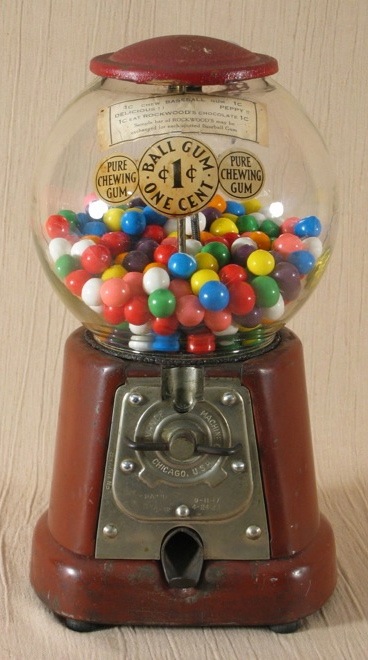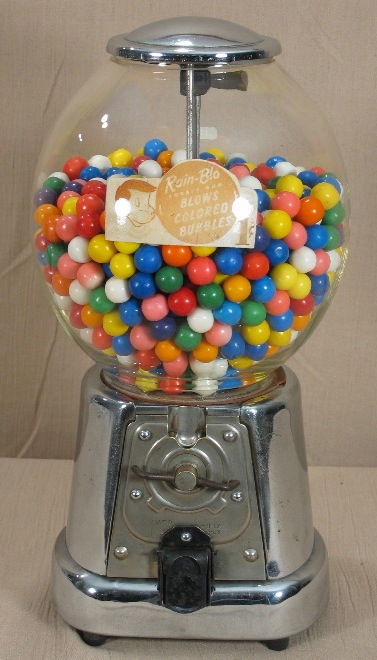___________________________________________________________________________________________
Advance Model D


___________________________________________________________________________________________


Advance Machine Company, Chicago, IL, c. 1923, 12 1/2" (short globe, on the left); 15 1/2" (tall globe, on the right). This is the sister non-binary gender-neutral sibling model to the Advance Big Mouth but is more common. It's made of rolled steel and vends a gumball for a penny. The model is correct with a small round Advance globe or a large Advance football globe, as shown above. It may also be correct with a small Advance football globe but I tend to associate that one with earlier Advance models like the cast iron Gumball and the transitional Gumball.
When I first started collecting I wanted a Model D because I thought it looked great and was old. I saw the patent date of 1923 and figured it must be ancient, not realizing that Advance made this model into the 1940s and maybe even the 1950s. My perception of "old" has also changed a bit between then and now. I finally got one and cherished it for several years, and then one day had an epiphany: This is a pretty common machine. It's good-looking and designed well, which is why Advance sold 1.28 gazillion, but I've come to think of them more as Victor Topper-type common rather than the early gem I once thought they were. I still like it, though.
Red paint is by far the most common finish for this model. I've seen some painted gold hammertone and once heard of a batch that showed up years ago at the Chicagoland show with original green hammertone paint. Most red machines with original paint have a slew of patent numbers stenciled in black paint on the bottom. If you don't see that feature on a red machine then it's probably been repainted at some point, although there's no guarantee of that. I have a red Model D that I swore has original paint but it doesn't have the patent numbers listed on the bottom---but, man, the paint looks soooo original---and then one day I noticed a couple of patent dates (not patent numbers) stenciled in black on the machine's back near the bottom of the midsection. This confirmed the paint's originality, but Advance hadn't stenciled the patent numbers onto the underside of that one so it breaks the rule. I haven't checked the bottom of a gold or green hammertone machine, so I don't know the stencil status of those variations.
This model was also available chromed. It's gettable but is far less common than the red painted version. The machines I've seen with original chrome don't have the patent numbers stenciled onto the bottom. I believe the chrome finish was a later option, so Advance may have given up the practice by then.
Some examples I've seen have "PAT PEND" stamped into the front plate where the 1923 patent date is stamped on most Advance D's. I assume those are earlier examples. Another small variation on the front plate is the shape of the wire handle; on most (including both examples above) the ends of the handle flare out, but on some the ends are curved more tightly back toward the center of the handle, forming a right angle to the front plate and a shorter radius than that on the more flared handle. I've noticed the shorter radius on machines with "PAT PEND" instead of the 1923 patent date, so methinks the short-radius handles are earlier.
The red example above is one of the best-looking Advance Model D's I've ever seen. It's 100% original and has not one, but 2(!) original decals on the globe. Most Model D's don't have an original decal, so finding one on a globe is tough. The chrome machine above has an original finish in excellent condition. It also has a gate, which on this machine is a nicely done vendor modification. The gate's not original, but the inventiveness and quality of this vendor-mod enhances the machine rather than degrades it. It's not a downgrade, it's a feature.
___________________________________________________________________________________________
___________________________________________________________________________________________
©Small Vintage Vending 2024